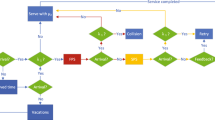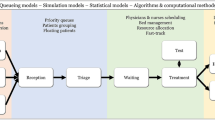Abstract
As a model of a service center with multiple servers and prioritized impatient customers served in reverse order of arrival such as the 9-1-1 call center in the United States, we study an M/M/\( m \) nonpreemptive priority (last-come, first-served within the same class) queueing system with impatient customers in the steady state. We analyze the waiting time for those customers who are served successfully and the time to abandonment for those customers who leave the system while waiting. Explicit formulas are given for the probabilities of service and abandonment as well as the mean and second moment of the waiting time for customers of each class. Numerical examples are shown in order to demonstrate the computation of theoretical formulas. The difference in the behavior of the waiting time from that in the corresponding first-come, first-served system is discussed.

















Similar content being viewed by others
References
Cobham, A. (1954). Priority assignment in waiting line problems. Operations Research, 2(1), 70–76.
Cooper, R. B. (1972). Introduction to queueing theory. New York: The Macmillan Company.
Cooper, R. B. (1981). Introduction to queueing theory (2nd ed.). Amsterdam: Elsevier North Holland.
Davis, R. H. (1966). Waiting-time distribution of a multi-server, priority queuing system. Operations Research, 14(1), 133–136.
Gautam, N. (2012). Analysis of queues: Methods and applications. Boca Raton: CRC Press.
Gnedenko, B. V., & Kovalenko, I. N. (1989). Introduction to queueing theory, second edition revised and supplemented. (Samuel Kotz, Trans.). Boston: Birkhäuser.
Iravani, F., & Balcıog̃lu, B. (2008). On priority queues with impatient customers. Queueing Systems, 58(4), 239–260.
Jagerman, D. L. (2000). Difference equations with applications to queues. New York: Marcel Dekker.
Jouini, O. (2012). Analysis of a last come first served queueing system with customer abandonment. Computers & Operations Research, 39, 3040–3045.
Jouini, O., & Roubos, A. (2014). On multiple priority multi-server queues with impatience. Journal of the Operational Research Society, 65(5), 616–632.
Kella, O., & Yechiali, U. (1985). Waiting times in the non-preemptive priority M/M/\( c \) queue. Stochastic Models, 1(2), 257–262.
Kulkarni, V. G. (1995). Modeling and analysis of stochastic systems. London: Chapman & Hall.
Larson, R. C. (1987). Perspectives on queues: Social justice and the psychology of queuing. Operations Research, 35(6), 895–905.
Mandelbaum, A., & Zeltyn, S. (2007). Service engineering in action: The Palm/Erlang-A queue, with applications to call centers. In D. Spath & K.-P. Fähnrich (Eds.), Advances in services innovations (pp. 17–45). Berlin: Springer.
Riordan, J. (1962). Stochastic service systems. New York: Wiley.
Subba Rao, S. (1967). Queuing with balking and reneging in M/G/1 systems. Metrika, 12(1), 173–188.
Takagi, H. (2014a). Waiting time in the M/M/\(m/(m+c)\) queue with impatient customers. International Journal of Pure and Applied Mathematics, 90(4), 519–559.
Takagi, H. (2014b). Waiting time in the M/M/\(m\) FCFS nonpreemptive priority queue with impatient customers. International Journal of Pure and Applied Mathematics, 97(3), 311–344.
Taylor, H. M., & Karlin, S. (1998). An introduction to stochastic modeling (3rd ed.). New York: Academic Press.
Whitt, W. (2005). Engineering solution of a basic call-center model. Management Science, 51(2), 221–235.
Wolff, R. W. (1989). Stochastic modeling and the theory of queues. Upper Saddle River: Prentice Hall.
Zeltyn, S., Feldman, Z., & Wasserkrug, S. (2009). Waiting and sojourn times in a multiple-server queue with mixed priorities. Queueing Systems, 61(4), 305–328.
Author information
Authors and Affiliations
Corresponding author
Rights and permissions
About this article
Cite this article
Takagi, H. Waiting time in the M/M/\( m \) LCFS nonpreemptive priority queue with impatient customers. Ann Oper Res 247, 257–289 (2016). https://doi.org/10.1007/s10479-015-1876-7
Published:
Issue Date:
DOI: https://doi.org/10.1007/s10479-015-1876-7
Keywords
- Queue
- Waiting time
- Last-come first-served
- Multiserver
- Nonpreemptive priority
- Impatient customers
- Polite customers
- Abandonment




